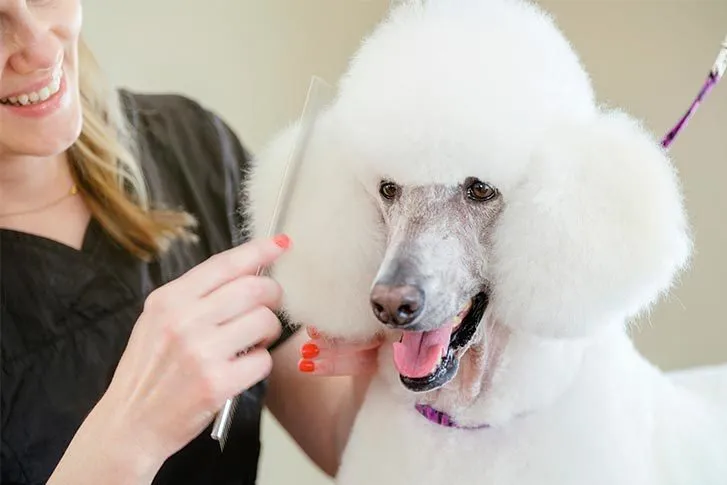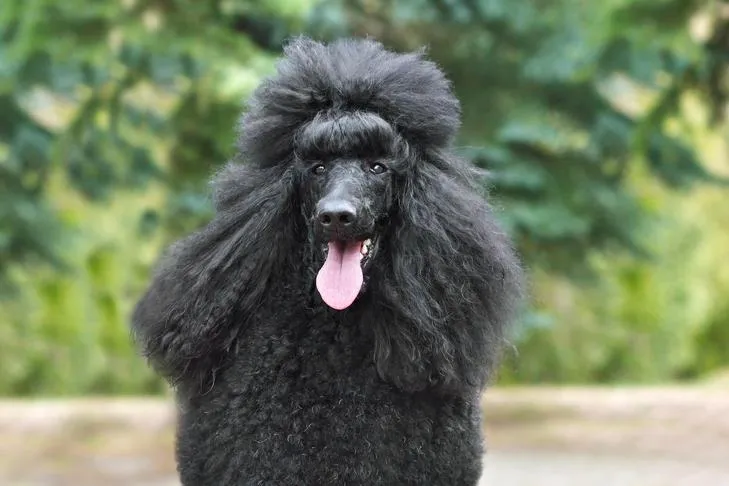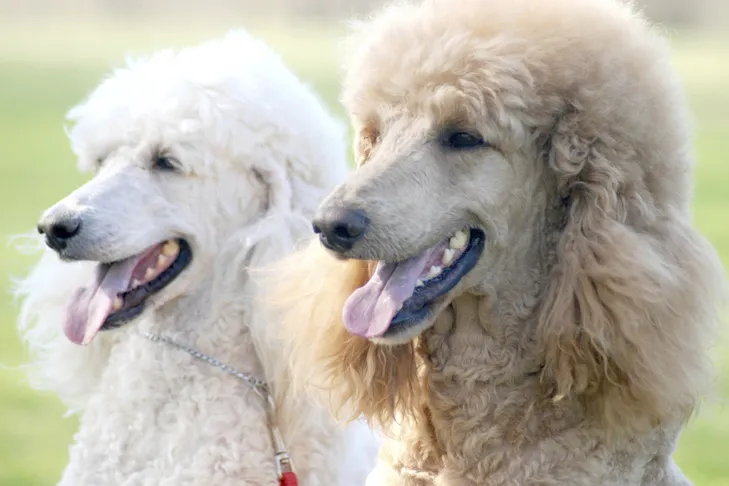Achieving the iconic look of a Standard Poodle isn’t just about aesthetics; it’s about dedicated care and consistent grooming practices. While Poodles are celebrated for their non-shedding coats, a trait many dog owners adore, this advantage comes with a commitment to routine grooming. This guide, drawing on insights from Poodle experts, will walk you through everything you need to know about caring for your Poodle’s unique coat, skin, nails, and overall hygiene to ensure they remain healthy and looking their best. Establishing good grooming habits early on not only maintains their distinctive appearance but also strengthens the bond between you and your cherished canine companion, preparing them for a long and happy life with you. Understanding what age a dog is considered senior can also help tailor their care as they mature, ensuring their grooming needs evolve with them.
Coat Care Fundamentals: Brushing and Bathing Your Poodle
The journey to excellent Poodle Hair Care begins the moment you welcome your Poodle puppy home. Instilling good grooming habits from an early age is crucial, starting with regular brushing to prevent matting, which can be uncomfortable and lead to skin issues.
Gail Wolaniuk, a professional Poodle handler and groomer with 40 years of experience, emphasizes the importance of a slicker brush—a tool with a square or rectangular head and short, stiff wire bristles. When brushing, ensure you reach all the way down to your puppy’s skin to thoroughly detangle, but always exercise caution to avoid scratching or scraping their sensitive skin. For better control and to establish a consistent routine, grooming your Poodle on an elevated surface like a grooming table is highly recommended. This practice not only makes the process easier for you but also helps your Poodle associate grooming with a calm and predictable experience.
Bathing frequency for Poodles typically ranges from every four to eight weeks, depending on how often you brush their coat and their activity levels. Since Poodles have continuously growing hair, much like human hair, you can use shampoos formulated for humans, such as Pantene or Suave, though a wide variety of specialized cleansing dog shampoos are also available, including whiteners, bodifiers, or clarifiers. These can cater to specific coat needs, enhancing shine and texture. Regular bathing, coupled with consistent brushing, forms the cornerstone of effective poodle hair care, preventing skin irritations and maintaining the coat’s health and luster.
Mastering the Art of Poodle Hair Trimming
Trimming your Poodle’s hair can be done as often as you bathe them, roughly every four to eight weeks. The frequency largely depends on your personal preference for hair length. For those who choose to trim their Poodle’s hair at home, Wolaniuk suggests using reputable clippers like Andis or Oster. These brands are known for their easy snap-on blades, making them suitable even for beginners.
For delicate areas such as the face, feet, and the base of the tail, Wolaniuk recommends using size 15 or 30 blades. It’s important to remember that a higher blade number corresponds to a shorter cut. For the body, a 4 to 7 blade typically works well for a short clip, depending on your desired length. DNA and health tests for dogs can offer valuable insights into your Poodle’s genetic predispositions, which might influence coat texture or skin sensitivity, guiding your grooming choices for optimal health.
Giving your Poodle a haircut at home demands patience and discipline. Taking your time and experimenting with different styles is part of the learning process. Wolaniuk offers reassuring advice: “Remember hair always grows so any mistakes you make will be corrected with time as it grows in.” Grooming sessions, including bathing and trimming, also provide an excellent opportunity to conduct a thorough health check. Look for any unusual cuts, growths, or signs of parasites like fleas or ticks. If you observe any wounds or significant changes to your Poodle’s skin or coat, it’s crucial to consult your veterinarian promptly. Early detection of issues like my old dog has a swollen stomach or other health concerns can make a significant difference in treatment outcomes.
 Standard Poodle being professionally groomed.
Standard Poodle being professionally groomed.
Show Poodles vs. Pet Poodles: Grooming Differences
While the fundamental poodle hair care techniques remain consistent for all Poodles, whether they are beloved companions, performance dogs, or conformation show dogs, there are distinctions in required trims. Wolaniuk explains that “The main difference is the required trims needed in conformation show dogs. The guidelines to the required trims are outlined in the breed standard, set forth by the parent clubs (Poodle Club of America).”
Younger Poodles destined for the show ring are typically presented in a “puppy trim,” a charming and less elaborate style. As they mature, adult show Poodles transition to more intricate styles such as the “Continental” or “English Saddle Trim.” These styles are characterized by longer hair in specific areas, demanding more intensive and ongoing coat care to maintain their impeccable presentation. This dedication to specific cuts highlights the artistry and precision involved in competitive Poodle grooming.
 Poodle head portrait outdoors.
Poodle head portrait outdoors.
Essential Nail Care for Standard Poodles
One of the often-overlooked aspects of poodle hair care is regular nail maintenance. Wolaniuk advises that your Poodle’s nails are too long if you can hear them clicking on the floor as they walk. Untrimmed nails can lead to discomfort, pain, and even structural issues in their paws over time.
You have several effective options for keeping your Poodle’s nails trim. You can use a dedicated nail trimmer designed for dogs, a nail grinder, or a combination of both tools. A grinder allows for more gradual shortening and smoothing of the nails, typically performed once a week. Alternatively, you can clip the nails first and then use a grinder to smooth any sharp edges, achieving a refined finish. It’s important to be prepared when clipping. Wolaniuk recommends always having Kwik-Stop handy. This styptic powder is invaluable in case you accidentally cut the quick, which is the blood supply to the nail. While cutting the quick can cause a brief moment of bleeding and discomfort, it’s not a major problem, and applying Kwik-Stop will quickly stop the bleeding.
 Standard Poodles head portrait outdoors.
Standard Poodles head portrait outdoors.
Maintaining Your Poodle’s Dental Health
Beyond their beautiful coats, a Poodle’s overall health, including their dental hygiene, is paramount. For ongoing dental maintenance, Wolaniuk suggests providing your Poodle with appropriate hard chews, such as specific types of bones, antlers, or Himalayan chews. These can help reduce plaque and tartar buildup through natural abrasion. Regular dental care is not just about fresh breath; it’s a vital component of their general well-being.
In addition to chew toys, daily brushing is highly recommended. Use a toothbrush designed for dogs, such as a traditional dog toothbrush or a finger toothbrush, coupled with a toothpaste specifically formulated for canines. Never use human toothpaste, as it can be toxic to dogs. Brushing helps remove food particles and plaque, significantly reducing the risk of gum disease and other dental problems. Of course, regular professional dental cleanings with your veterinarian are indispensable for comprehensive oral health. These professional cleanings can address issues that at-home care might miss, ensuring your Poodle’s teeth and gums remain healthy throughout their life.
Standard Poodle Ear Care: A Critical Component
Poodles are prone to ear issues due to the hair growth inside their ears and their characteristic drop ears, which can restrict airflow and create a warm, moist environment conducive to wax buildup and infections. Therefore, dedicated ear care is a critical aspect of poodle hair care.
Regular cleaning is essential. You can either pluck or trim the hair that grows inside their ears. Wolaniuk explains, “The more hair you pluck out or cut out allows a better airflow to help the inside of the ear to stay dry.” This improved ventilation helps prevent moisture from accumulating, which is a common cause of ear infections. In addition to hair removal, use an ear-cleaning solution specifically designed for dogs. This solution helps to dissolve and remove excess debris, wax, and dirt, and aids in maintaining the proper pH levels within your dog’s ear canal. Consistent ear care will help keep your Poodle comfortable and prevent painful infections, contributing significantly to their overall health and happiness.
Conclusion
Caring for your Poodle’s unique needs, especially concerning their hair, requires a consistent and thoughtful approach. From daily brushing to regular bathing, precise trimming, diligent nail care, attentive dental hygiene, and crucial ear maintenance, each step plays a vital role in ensuring your Poodle’s health, comfort, and signature elegance. Embracing these grooming best practices not only keeps your Poodle looking splendid but also offers invaluable opportunities for bonding and early detection of any potential health concerns. Remember, a well-groomed Poodle is a happy and healthy Poodle. For more in-depth advice on canine health and care, explore our other articles on dog care stories.
